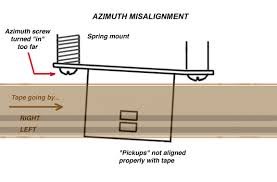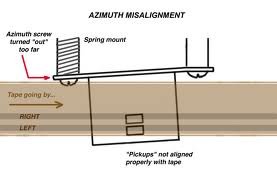RX-5050 head is a very simple tape head. It can only make the head align parallel to the track. The adjustment for max sweep on recorded tracks is all fixed in the design of the head assembly.
It is not complex like an auto reverse or other professional audio heads.
Ambience to feel equally on both channels is not easy. I don't think a young guy like you have any hearing loss. In fact I have some hearing loss on my right ear.


I wouldn't try any alignment myself just by listening.
Always use the best recorded 'Reference Tape' for the alignment. One only can get the head aligned parallel like Alberto mentioned. That doesn't mean the area of coverage of the head is the best on both tracks of the tape.
I remember Fatdog had a thread showing how he did the head alignment.
In teh RX5050 only the right spring loaded one is for any alignment adjustment. Since it is off alignment I would adjust both screws slightly and see if that makes a difference and not only the spring loaded one to get more sweep area of the individual channels on the tape (area of contact) on both tracks of the head.
See this..
https://www.youtube.com/watch?v=YhvqOtWwQ1E
There are five basic head alignment checks to make.
They are azimuth, zenith, wrap, height, and tape-to-head contact.
Azimuth is probably the more critical alignment, because this is what will cause the phase cancellations. An improper azimuth adjustment will show up on playback through phase cancellations, because in effect it creates a time discrepancy between the tracks.
Azimuth is the alignment of the heads perpendicular to the direction of tape travel. If the azimuth is misadjusted, any program recorded on both tracks will be played back slightly out of phase.
Zenith is the alignment of the heads in the same plane as the tape. For example, the bottom of the head can be kicked out too far, which may cause the top tracks not to fully contact the head, and would cause the tape to ride up on the head, snapping back down occasionally. The zenith can also be misaligned so that the top of the head is shoved too far out. The head should be aligned so that the tape rides against it with smooth contact to the entire surface.
Wrap is the alignment of the head so that the tape contacts the head at the center, aligned with the head gaps. The wrap adjustment causes the head to swing in an arc centered on the middle of the head, and moves the center of the head from the left to the right of center, depending on which way you adjust the screw.
Head height is adjusted so that the tape rides perfectly centered from top to bottom on the head. You can tell this immediately just by looking at the tape as it rides across the heads.
Tape-to-head contact is just that - the head should be positioned far enough into the tape path to ensure good contact with the tape. If it were too far back, insufficient pressure would cause playback to be inconsistent.











